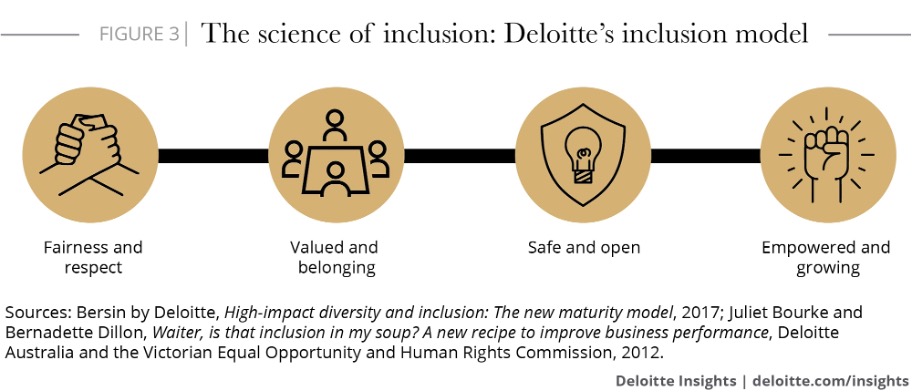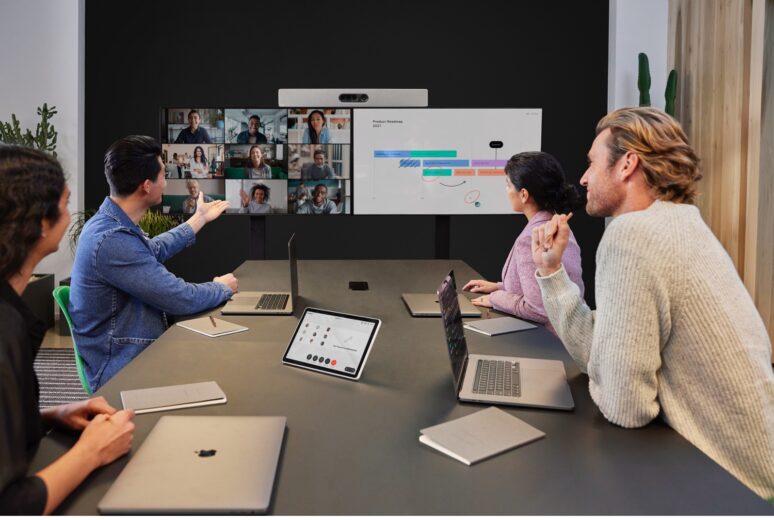Team collaboration in 2022: Why it’s important and 4 ways to improve it

Collaboration has always been foundational to a team’s success. But now that we’ve entered the era of hybrid work, there are new obstacles to consider when it comes to team collaboration. It’s one of the biggest challenges facing organizations today.
But it’s not only a question of technology. Sure, solving audio problems and troubleshooting network connections are magnified by the nature of hybrid work, but the team itself, how it functions and tackles problems, may face a steeper uphill climb in this new normal.
So, what exactly is team collaboration? How does it need to evolve in the era of hybrid work? And how can you improve team collaboration for your organization?
Let’s dive into it!
- What is team collaboration?
- 4 ways to improve team collaboration
- How to assess inclusivity
- How to foster empathy in the workplace
- How to pivot from listening to respond to listening to understand
- How to practice giving candid, actionable feedback
- Conclusion: What it all means in terms of hybrid work
What is team collaboration?
The dictionary tells it simply enough: collaboration is the act of working with someone to produce or create something. Artistic twosomes like Patti Smith & Robert Mapplethorpe, John Lennon & Paul McCartney, or Big Boi & Andre 3000 come to mind. It’s all about synergy and opposition, a yin and yang of style and perspective.
But when we look at team collaboration, the ideas should flow from everyone. I like to think of team collaboration as an interplay between personalities, expertise, and creativity that fuels effective problem-solving toward a common goal. The goal could be ongoing (a contact center team providing excellent customer service). It could be singular (a basketball team pursuing an NBA championship). Or it might be a bit of both (a sales team implementing a new leadership structure while exceeding YoY targets).
Workplace collaborations are distinct from artistic collabs because they typically have a broad business objective as their guiding star. Under this umbrella, everything from department goals to team and individual goals needs to be considered. This can be daunting—how do we creatively solve the problem together while staying in the framework of company goals?
As a team, it’s not only incumbent on leaders to understand the dynamics that fuel collaboration. Everyone needs to put in thought and effort to understand the differences in personality, expertise, and creative problem-solving within the team.
The goal of improving team collaboration is to reach a level of interpersonal comfort where everyone feels secure sharing ideas and giving valuable feedback. But we can’t snap our fingers and give people the accountability and thoughtfulness that requires.
We need to take strategic steps to reach that goal.
4 ways to improve team collaboration
The first step to improving team collaboration? Assess how inclusive your culture is. Second, work to foster empathy between team members to help build an inclusive culture. Third, emphasize listening to understand instead of listening to respond. And fourth, take time to explore what goes into actionable, candid feedback.
These four steps are interrelated. You can’t build an inclusive culture without empathy. It’s difficult to empathize if you don’t listen to understand. And listening to understand is crucial to giving valuable feedback.
Let’s explore each step in more depth.
How to assess inclusivity
Let’s consider inclusivity from the perspective of both leader and team member.
In a survey of more than 4,000 employees, Harvard Business Review found inclusive leaders exhibit the following traits:
- A willingness to share personal weakness.
- A dedication to learning about cultural differences.
- A focus on acknowledging team members as individuals.
In the same study, the researchers found:
“…inclusive leadership is not about occasional grand gestures, but regular, smaller-scale comments and actions… inclusive leadership is tangible and practiced every day.”
In busy, competitive environments, we’re often pivoting from one deadline to the next. Those small, everyday gestures of positive reinforcement can fall by the wayside. We all know it’s a challenge—the question is, will each person put in the effort to build a more inclusive team?
The aforementioned traits shouldn’t be considered leader-only traits. They’re important for workers of all stripes. However, we have to delve into inclusivity from the POV of non-leadership roles too.
Analysts at Deloitte created a 4-pillared model for inclusion, shown below:

What Deloitte found when organizations implemented this model is fascinating:
“…an increase in individuals’ feelings of inclusion translates into an increase in perceived team performance (+17 percent), decision-making quality (+20 percent), and collaboration (+29 percent).”
Just by putting an emphasis on inclusion from the top-down, outlooks began to improve. Plus, when you make it known that improving inclusivity is a priority, and that feedback is welcome, it becomes a bit of a self-fulfilling prophecy (in a good way). Teams will offer the feedback you ask for because they want more opportunity to contribute. You’ll gain insights into which processes are inclusive and what needs work.
Technology can also support more inclusive team collaboration. Video conferencing software with noise removal is a boon to colleagues with little ones at home. Real-time translation allows global teams to include everyone. And closed captioning makes meetings accessible for all.
As you measure the level of inclusiveness in your team, consider the following questions:
- Are all team members contributing during meetings?
- Do they feel that their work will help them learn and grow as professionals?
- Does everyone communicate respectfully, particularly when it’s crunch time?
- Do team members feel comfortable sharing new ideas and giving feedback to their colleagues?
- Is your team equipped with a collaboration solution that facilitates more inclusive practices?
These are questions that should be discussed across the board, outside of things like the annual review process. But, once you have a sense of how inclusive your team is, what do you do to improve it?
That’s where empathy comes in.

How to foster empathy in the workplace
Empathy is often thought of as a collaborative skill. But neurobiology tells us that empathy is more of a trait, one that’s coded into virtually every human brain. For the most part, we’re all capable of feeling empathy. The challenge is using your own capacity for empathy in an effective way.
Often, we can be our own worst enemy. In a series of studies by researchers at the University of Toronto, it was found that when given the choice, 65% of respondents would more often choose not to engage with content that required empathy.
A quote from these studies sheds light on why:
“Participants reported that empathy felt more cognitively challenging, saying it required more effort… Participants who reported that feeling empathy was mentally demanding or made them feel insecure… were more likely to have avoided the empathy deck.”
There’s no way around it: empathy is about effort. It’s hard! You have to put the work in, especially when it comes to day-to-day communication with your colleagues.
Putting empathy into action can take a variety of forms. Here are a few thought-starters:
- Make time for small talk. In the hybrid work era, casual small talk is something remote workers are missing. Try to reach out with non-work questions or check-ins regularly. You may learn something new about your colleagues.
- Geography matters. Sending urgent 5pm PST emails to east coast colleagues is an obvious faux pas, but you can also think proactively about location. For example, small notes of comfort during hurricane or fire season for coworkers in those regions can mean a lot.
- Know what your coworkers actually do. Ask questions about your colleagues’ roles. Try to understand misconceptions they come across. This will help you advocate for them in cases where they’re asked to do too much.
- Embrace the corniness. Things like meeting icebreakers can feel silly, but they also tend to work in easing awkwardness and opening up new avenues of conversation. Embrace it!
As you start planting the seeds of empathy for your team, fresh sprouts will inevitably begin to grow. They may flower into unexpected insights, hilarious coincidence, even lifelong connections. They can also bloom into new opportunities and spark more engaging dialogue.
How to pivot from listening to respond to listening to understand
It’s easy to fall into passive-listening-mode in a hybrid work environment. Wrapping up an email or answering a message, reviewing a project—we’ve all succumbed to the allure of multi-tasking (even though the concept is a complete myth!). This is important to mitigate within your team and so too is listening to respond.
This approach to listening can be detrimental to team collaboration. We calculate our response while the speaker is talking with an intent that is typically not neutral, like offering a unilateral solution without fully taking in the speaker’s message. There’s little chance of establishing common ground, of understanding the speaker.
Active listening, on the other hand, is considered a foundational tool in most occupational fields. Also referred to as empathic listening (yep, empathy touches almost everything), it’s a technique you’ve probably encountered in your professional life.
In broad strokes, active listening prescribes maintaining neutrality, asking questions where appropriate, and offering consistent verbal and nonverbal feedback.
Listening to understand is an iteration of active listening, utilizing neutrality and a form of verbal feedback called reflecting. While the listener actively works to interpret the speaker’s intent, they engage by summarizing and repeating the speaker’s points back to them at appropriate moments (reflecting). This stimulates understanding and level-sets the discourse for listeners.

Research tells us this helps both speakers and listeners feel more understood and satisfied after conversation. Some ideas for helping your team adopt this method:
- Mock presentations. Encourage team members to present their ideas with the explicit goal of having colleagues hone their listening-to-understand skills. Leaders can give people guardrails for what and what not to do in this exercise.
- Rotating representatives. Use some positive reinforcement by delegating your role as team rep in a meeting to a colleague. Give them all the background info they need and let them be the point person for note-taking and action items.
- Person-to-person workshopping. Impromptu creative sessions are more challenging in a hybrid work environment. Using asynchronous video tools can help colleagues practice their speaking or listening skills and makes it easier to offer feedback!
We can also strengthen this habit by using our refocused attitudes toward inclusivity and empathy to understand unique conversational styles.
In an episode of the Hidden Brain podcast, linguist Deborah Tannen discusses conversational styles and how much of a minefield they can be to navigate.
In one example, she records a conversation between close friends and family, including folks from England, California, and New York.
If you listen, you’ll notice a clear difference in cadence and assertiveness. New Yorkers talk faster, are more willing to interrupt, but also cut in to support the speaker’s point. Californians are less willing to grab the reins or interrupt, and, evidently, less attuned to the New Yorkers’ rhythm.
As Tannen notes:
“We need a sense of how long a pause we think is normal between turns. And the New Yorkers’ sense of how long a pause was normal was shorter and so while the Californians… were just waiting for a normal pause… one of the New Yorkers would get the sense, ‘Uh-oh, they have nothing to say, we might as well fill this pause.’”
This illustrates both the synergy of conversing with someone who’s on the same page as well as the awkwardness of conversing with someone who has a different style (hello again, empathy). At one point, Tannen attempts to force the issue with her Californian guests. In what she calls “machine gun questions,” Tannen uses a rapid-fire approach to engage:
Tannen: Do you live in LA?
Carl: Yeah.
Tannen: Are you visiting here?
Carl: Yes.
Tannen: What do you do there?
Carl: I work at Disney. Walt Disney.
Tannen: Are you a writer? Artist?
Carl: Yeah.
Tannen: Writer?
Carl: Yeah, I write, advertising copy.
What Carl doesn’t know is that she already knows the answers to these questions. She’d gotten the details from another friend before the party.
It’s a bit of a paint-by-numbers approach. It goes beyond listening to understand into almost interrogating-to-understand territory. How can you listen to understand when the understanding exists independent of both listener and speaker?
This example is essentially empathy gone wrong. She wants the guest to feel more comfortable, but, as we can hear in the clipped responses, they check out almost instantly. Her inclination is empathetic, the execution is just misguided. But it echoes that additional effort we sense (and sometimes dread) when trying to talk to a disengaged colleague or friend.
Idiosyncratic differences in humor, cadence, even logical framing, aren’t easy to account for in a team setting. You need to make conversation a given, as a team, leader to team member, and teammate to teammate. And loose—albeit constructive—goals can help.
Maybe you want help avoiding verbal tics in presentations or being less passive in brainstorm sessions. Whatever the goal is, creating an open, running dialogue within your team on conversational style can bring team members together on a human (and humorous) level.
Now that we have a better understanding of the nuances of listening and conversation, it’s time to put it all together and explore the final piece: giving actionable, candid feedback.
How to practice giving candid, actionable feedback

Basketball teams at their best exemplify what team collaboration can be. It’s the most naked of the Big 4 American sports. The arenas are comparatively small, the court even more so. There are no helmets, hats, pads, and very little equipment to speak of. You can see a player’s body language, their expressions, and you can gauge a team’s sense of togetherness by these measures, even outside of how they play. When a team clicks, you can see it in the way the ball moves and how a defense stretches, rotates, and resets—but also in how players interact with each other.
It’s a sport that embodies a lot of what we’ve talked about in this piece. A 15-person roster and 10-person coaching staff can’t be successful if the culture isn’t inclusive. The nature of the game demands everyone gets a few touches to feel part of the collective. You travel together, practice together, compete together. Without empathy, you won’t survive. And when you’re being coached up, the only viable option is to listen to understand.
The 2021 NBA Champion Milwaukee Bucks have had an interesting trajectory, one tied to the rise of Greek superstar Giannis Antetokounmpo. After playoff disappointments led to the firing of Coach Jason Kidd in 2018, the team took off under Coach Mike Budenholzer. After a win, Giannis was asked about the difference between the coaches:
“Jason would have yelled at us and we would have stayed close[d] in a shell… when guys got yelled at, they had a tendency to not play as hard. [Coach Bud is] going to talk to you. Like when you’re messing up, he’s going to let you know… when you’re doing good stuff, he’s always going to tell you and make you feel positive.”
Sounds familiar, right? We all know what tough, fair feedback feels like. It’s not personal. It’s well thought out and considerate. It’s constructively critical. It makes us think differently. It’s candid.
Harsh feedback is likewise easy to spot. It might sound abrupt, or perhaps is delivered clumsily. It may be generic to the point it doesn’t feel thought through, or offers a solution that doesn’t totally make sense (hello, listening to respond).
Author, thought leader, and workplace innovator Kim Scott has devised an interesting model for feedback. The ideal state of feedback, Scott says, is “radical candor.” Boiled down, this method is a cross of zero BS and real, personal caring. You can’t have the former without the latter.
Scott retells an important aha moment in her career. Giving presentation feedback, her manager had to resort to a level of bluntness that could easily cross the line for some:
“…Scott brushed off the concern. ‘Finally, Sheryl said, You know, Kim, I can tell I’m not really getting through to you. I’m going to have to be clearer here. When you say um every third word, it makes you sound stupid.’”
For many, using a word like that tips the feedback from candid to personal. But the longtime relationship between the two is what made this feedback ok—the real, meaningful friendship and mutual respect developed over years of collaboration and trust. In other words, their relationship was grounded in empathy and inclusion. The relationship actually demands that kind of candor. You’d expect nothing less from a close friend or colleague, right?
Scott breaks down everything about radical candor in the video below—it’s a bit long so if you want to hear her relay the aha moment, start around 2:27.
Recently, the concept of unapologetically candid feedback was scrutinized in HBR. The authors make a compelling argument against the idea of feedback entirely. After defining feedback in standard, generic terms—offering one’s thoughts on improving performance—the authors go on to state:
“Telling people what we think of their performance doesn’t help them thrive and excel and telling people how we think they should improve actually hinders learning.”
Breaking down the article would require a whole separate piece, but their thesis aims to refute the method of radical candor altogether. The authors cite research showing how the human brain does not learn as well from feedback on flaws as it does from reinforcing strengths, that focusing on poor performance does the exact opposite of what feedback is intended to do: spur personal and professional growth.
The article made enough waves to warrant a point-by-point response from researchers arguing for some softer components of the radical candor method. But they find general points of agreement around the following:
- Potentially harsh feedback is generally not helpful for people to excel and must be given thoughtfully.
- Telling people what they’re doing well is shown to spur professional improvement.
- Offering black and white solutions (listening to respond rearing its ugly head again) is much less effective than asking questions and reflecting.
It’s here that we find these researchers and thought leaders—including Scott—circling around a relatively simple truth:
There’s no one-size-fits-all approach to feedback!
One person’s harsh is another person’s candid. The feedback Scott received was acceptable not just because of her relationship with the feedback-giver, but because she had the personality that fit the feedback. If we swapped another professional for Scott, they might not react the same way. But does that mean this individual doesn’t have what it takes to grow professionally? Not necessarily.
We have to fine-tune our feedback based on what we know about our colleague, which is deeper and more specific once you’ve done the work to improve inclusivity and practice empathy.
Some simple ways to improve peer-to-peer feedback follow:
- Virtual suggestion box. Give everyone the opportunity to describe how best they receive feedback, in what medium and on which projects they want.
- Open forum on process. Use the timeless headache of operational process to unite! Let everyone know that the goal is to make a given process better, but to use the open forum to practice giving actionable, candid feedback.
- Reflect on past feedback. Take inventory. What specifically has constituted unjust or harsh feedback? Conversely, what does the best feedback you’ve received have in common? Use this as a guide to build your own individual approach to feedback.
The onus is on all of us, leaders and team members, to build the interpersonal relationships that allow us to give candid, actionable feedback to our colleagues in a way that fits their personality.
The end of Giannis Antetokounmpo’s coaching assessment distills it rather perfectly:
“With Coach Bud, it’s always coming from a good place.”
When you know your colleague listens without judgement, you know their feedback is coming from a good place. But we must realize everyone has a slightly different good place, and we can only discover that good place by putting the work into cultivating an inclusive, empathetic working environment.
Conclusion: What it all means in terms of hybrid work
Even if you have a good sense of how to approach improving inclusivity and empathy, of how to practice listening to understand and give actionable feedback, there’s still the question of hybrid work.
Luckily, there’s technology to make these four steps even easier to put into practice:
- Webex features like noise removal, real-time translation, and closed captioning promote an inclusive culture by widening the scope of access.
- With asynchronous video tools like Vidcast, you use specific, dedicated messages to team members as a means of practicing empathy.
- 4k HD video, gesture recognition, breakout rooms… these are all features that help you hone your ability to listen to understand.
- And with solutions like immersive share, real-time interactive whiteboarding and even live polling, you can feel empowered to give and receive feedback in a clear-cut, positive way.
____________________________________________________________________________________
*Related to the Blog post above.
Current Technologies CLC also has the following Custom Collaboration / WebEx courses, click the link below.
Check out our Custom Collaboration Courses.
If you have any questions let us know.
Current Technologies Computer Learning Center
6210 Central Avenue
Portage, Indiana 46368
Phone: 219-764-3800
Fax: 219-764-3805
Email: info@ctclc.com
.png)






